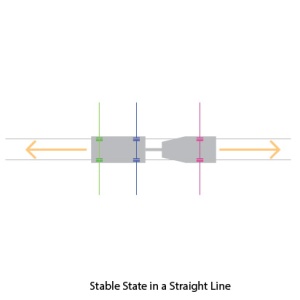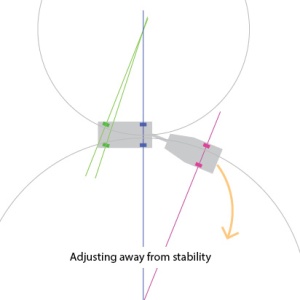I’m not terribly accomplished in the manly arts. I can’t throw a football, work a barbecue grill, or even begin to recite the rules for poker. I put my chances of landing a high five at about 50/50.
But, tell you what, I can back a trailer.
And here’s why – In my brain I have a conceptual model that accurately predicts the behavior of a trailer relative to a car when going backwards. (See what I did there we’re back to conceptual models.) This ability to predict is the most important aspect of a conceptual model. I’ll get back to this.
Here’s how I think about backing up a trailer.
First, there are two dynamic states that describe the angle between the trailer and the car. Stable and unstable.
- In the stable state, when the car and trailer move, the angle at the hitch is fixed.
- In the unstable state, the angle at the hitch changes as the car and trailer move.
The stable state can exist on a straight line or circle and is true going forward or backward.
- If the car and trailer are moving in a straight line, all the axles are parallel.
- If it’s on a circle, all the axles point at the center.
Going forward, the unstable state is always in transition toward the stable state. This is why it is easier to go forward with a trailer. But going backwards, the unstable state is either changing toward the stable state or away from the stable state. The stable state is so fragile in fact, that it’s nearly impossible to maintain going backwards.
It’s the existence of these two different states of instability that renders more common advice about backing a trailer like, “Turn the wheel in the opposite direction,” half wrong. It will get you started and then get you into trouble.
Instead, think in terms of stable and unstable. If you are backing up in a straight line, and need the trailer to swing toward the driver side of the car, adjust the wheel (clockwise) to create an unstable state and as soon as you get the angle you want, turn the wheel (counter clockwise) to re-stabilize. They key is to learn to feel the difference between stable and unstable and to always stay close to that stable position. Most of your movement should be in a stable state either in a line or on an arc. Only use the unstable state in passing to make adjustments.
Finally, there is a state that you cannot get out of going backwards. As the angle at the hitch increases, the point of stability moves away from the center position of the steering wheel. If the angle is too much, the point of stability is no longer available via the steering wheel. No backwards motion can bring you back toward a stable state. You’re jackknifed and you’ll have to drive forward to regain access to stability.

What does this mean for user experience?
I’m sure an automotive engineer could poke some holes in this model. Especially the brilliant engineers that designed the dynamic steering system for Volvo trucks. There are factors such as the distance between each of the axles that are not part of my model but do affect the behavior. But there is a big difference between a functional model (how the system really works) and a cognitive model (how the user thinks it works). As long as the cognitive model allows me to confidently and quickly put a trailer where I need it, the difference is unimportant.
There are many important qualities to a good conceptual model. It must be intentional, coherent, and elegantly communicated to the user with a minimal cognitive load. But it’s primary purpose is to allow the user to predict the behavior of system being used.





